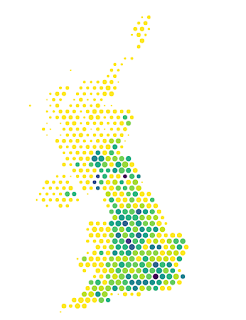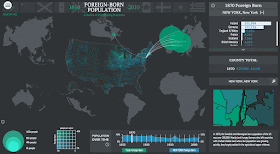Structured Procrastination on Cities, Transport Policy, Spatial Analysis, Demography, R
Sunday, February 28, 2016
Thursday, February 25, 2016
Wednesday, February 24, 2016
Where to find high spatial resolution data on population distribution
This post points you to six free sources of high spatial resolution data on population distribution.
5. [update Nov 2016] Eurostat and EFGS has also produced population-grid datasets in the years 2006 and 2011 for member countries of the European Union. They use a resolution of 1km and data from population and housing census. I thank Marcin Stepniak for the pointer.
6. Brazilian bonus: IBGE (the Census Bureau of Brazil) has also made publicly available a gridded population dataset with a resolution of 200 meters, which comes from the PhD thesis of Maria do Carmo Bueno at Nepo / Unicamp.
1. Gridded Population of the World (GPW) brings population estimates at a resolution of approx. 1km. This dataset results from a collaboration between CIESIN / Columbia University and Sedac / Nasa.
2. WorldPop brings population estimates at a resolution of approx. 100 meters for different years. This project goes a bit further as it also includes some population characteristics like age and sex structures, births, pregnancies, and poverty. The project is directed by Andy Tatem and it involves a number of collaborators from the University of Southampton, the University of Oxford, the World Bank and the Flowminder Foundation. They also do a fantastic job in terms of transparency, by getting their data and methods published in peer-review journals.
credit: Worldpop
3. More recently, CIESIN announced they are partnering with Facebook’s Connectivity Lab. The idea of the project is to create the highest resolution maps of population distribution ever created (5 meters) by applying image recognition algorithms to analyze high resolution satellite imagery. The project has already applied this method to 21 countries and the data output is gradually being released for download on their webpage (I thank Rafael Marinho for the pointer)
4. [update Oct 2016] Another source comes from the European Commission and its Global Human Settlement (GHS) framework, which combines fine-scale satellite imagery, census data, and volunteered geographic information. This project brings population estimates at resolutions of 250 meters and 1km approx for different years (1975, 1990, 2000 and 2015). I thank Jim for the pointer.
5. [update Nov 2016] Eurostat and EFGS has also produced population-grid datasets in the years 2006 and 2011 for member countries of the European Union. They use a resolution of 1km and data from population and housing census. I thank Marcin Stepniak for the pointer.
6. Brazilian bonus: IBGE (the Census Bureau of Brazil) has also made publicly available a gridded population dataset with a resolution of 200 meters, which comes from the PhD thesis of Maria do Carmo Bueno at Nepo / Unicamp.
Monday, February 22, 2016
Beyond the Hype: the future of transport looks remarkably familiar
A couple of months ago, Ted Novikov wrote an article about how autonomous vehicles will revolutionize real state markets and our urban experience more generally. Good food for thought. When I read his article, though, I have the impression those ideas sound a bit like non-sense extremely unlikely to happen in next 20 to 30 years. The main reasons for this are presented in a very clear way by Tim Schwanen in this article here. Tim's article is so concise that it really doesn't make much sense to reproduce his arguments here so I'd recommend reading his original text.
I have to say I've enjoyed reading Novikov's piece and I appreciate this kind of futuristic exercise. I reckon that this kind of thinking has a crucial role for us to re-imagine the future. Tim's article makes a strong case to why this hype around autonomous vehicles should be taken with a grain of salt.
ps. I thank Anthony Ling form calling my attention to this article, which has also been translated into Portuguese by Caos Planejado, a great Brazilian blog focused on urban planning, economics and innovation.
Friday, February 19, 2016
Commuting times and housing costs in eight major cities
Alan Smith has put together a nice series of charts comparing commuting times and housing costs compared in eight major cities for a piece in the FT. Good read. I thank Jakob Engel for the pointer.
Wednesday, February 17, 2016
Accepted with major revisions: resubmit
Biographical note: The 1st paper of my thesis has been accepted with major revisions after six months of the original submission . I I've just re-resubmitted the revised paper. I feel a bit relieved, I must say.
Sunday, February 14, 2016
Assorted Links
- A special issue from Science Magazine on The science of inequality
- How much does it cost to study in an Ivy League university?
- Meet the Robin Hood of Science and download any academic paper for free at Sci-Hub
- Beautiful photographic work on China's Ghost Cities
- Student hacks Raspberry Pi to run college bar at Oxford (ht Jakob Engel). The piece is from 2013, but I've heard the system is still working fine.
- How cold can Chicago get?
- A map of NYC street trees by species
- 3 years later, Syrian refugee camp booms into makeshift city
- A fairly detailed map of commuting trips in UK cities, by Oliver O’Brien
Tuesday, February 9, 2016
Share of the population living in the largest Metro Area
The chart was created by Aron Strandberg, who has a great Twitter account with lots of demographic data visualization. The data comes from the World Bank (here and here). I've included some related links below.
- If Christaller had Google Earth
- Urban Primacy
- Urban Primacy in Latin Ameria
- Demographic evolution of cities, 1950-2025
- The Urban Observatory
Monday, February 8, 2016
off-topic: Explore & compare place names from 13 countries
Open Data Zurich points out to this interactive application to explore names of places in 13 countries. The data comes from OpenStreetMap.
On a curious note on the catholic roots of Brazil, a bit over 10% of all 5565 municipalities in Brazil are named after a saint. This proportion is less than 1.5% in Italy.
Saturday, February 6, 2016
Urban Picture
A road sign found in Stockholm, Sweden on February 2nd 2016 (via The Economist). Brave new world :)
credit: The Economist
Friday, February 5, 2016
Historical international immigration to the US 1850-2010
John Weeks points out to this interactive map of international immigration to the US, based on population census data (1850 - 2010) .
This is probably one of the nicest dataviz of migration patterns I've seen and yet this is just one piece in a much broader project to build an atlas of the US History at the Uni. of Richmond.
This is probably one of the nicest dataviz of migration patterns I've seen and yet this is just one piece in a much broader project to build an atlas of the US History at the Uni. of Richmond.
credit: Digital Scholarship Lab
Thursday, February 4, 2016
Assorted Links
- The domestication of Amazonia before European conquest via Leo Monasterio
- A city of Pure imagination: great visual work of Víctor Enrich
- Places in the US with streets named after Martin Luther King Jr via Geoff Boeing
- paper: Based on CBA analysis, the cost of car driving in Copenhagen is more than six times higher than cycling
- This will change your internet
pornhabits sooner than you think - Where the population of Europe is growing – and where it’s declining
- The capital of Indonesia is the world's largest city without a subway. via Deden Rukmana
- Mapping the electrification of India over the past 20 years via Tanvi Misra
- John Lennon jams with Eric Clapton, Keith Richards & Mitch Mitchell
- Fertility in Jpan and USA, 1947-2010 via Randy Olson
* Bonus: It is ridiculously simple to create animated charts (.gifs) in R using gganimate
Wednesday, February 3, 2016
Pedestrian fatality risk as function of car impact speed
quick post today: Mikefc has created a very nice interactive chart showing pedestrian fatality risk as function of car impact speed using multiple risk models. Some of you might find it useful, specially for those involved in discussions/studies on road speed limits.









